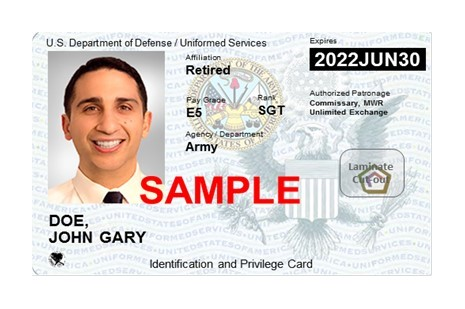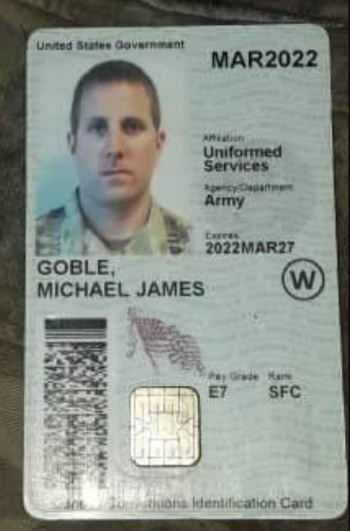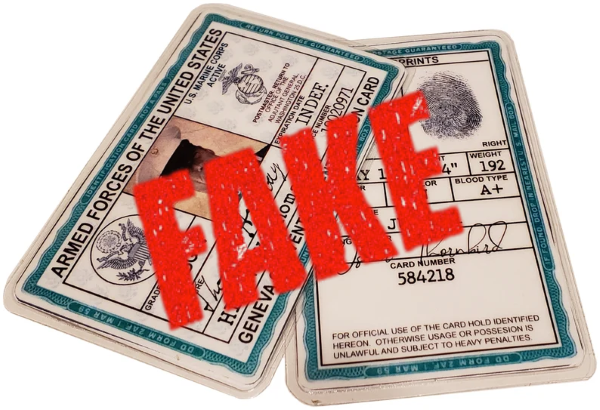Unfortunately, in the modern era, it’s relatively easy to obtain a fake military ID.
There are a variety of reasons people seek to steal a military ID or copy one, including access to hundreds of military discounts.
Consequently, it’s important to understand how to spot a fake military ID.
Thankfully, there are several warning signs and red flags that are common with artificial forms of identification.
It’s crucial for business owners and employees to understand how to properly check an ID.
As so, we introduce you to the techniques and 5 steps for identifying a fake military ID.
Related Article – How To Check If Someone Was A Navy SEAL
Table of Contents
Military Identification (CAC)

Sadly, fraud is very common, especially in terms of identity theft.
There are multiple forms of identity theft like using a fake ID to buy alcohol underage or receive a military discount that isn’t deserved.
For this reason, it’s important to understand the contents of a fake military ID, even if you are not a bouncer or store clerk.
Moreover, staying alert and aware keeps your personal information as a veteran protected.
As a result, take precautions to keep your Common Access Card (CAC) safe and secure.
The Department of Defense (DoD) currently designates CAC cards as the official identification for military personnel.
Military retirees and disabled veterans are eligible for CAC, along with active-duty personnel.
Furthermore, military spouses and dependents may also qualify for CAC.
The Defense Department ID (also known as the Uniformed Services ID card) confirms your service in the military.
For this reason, you can use it not only as a form of personal identification but to also receive benefits exclusive to veterans.
Veterans, for example, have access to hundreds of military discounts not available to civilians.
Notwithstanding, you’ll need correct identification to receive these exclusive deals.
Consequently, take the time and precautions to keep your CAC card secure and away from identity theft.
Types of Military ID

In general, the Department of Defense issues a Uniformed Services ID card, or CAC, to service members.
The “smart” card is utilized as standard identification for active duty personnel.
Moreover, CAC is also presented to Selected Reserve, DoD, and eligible civilian/contractor personnel.
The Common Access Card (CAC) grants personnel access to military services and programs.
Accordingly, it also provides access to DoD computer networks and systems.
There are 4 types of CAC cards:
- Armed Forces of the U.S. Geneva Convention ID
- U.S. Uniformed Services ID (or DoD Defense ID)
- U.S. DoD & Uniformed Services Geneva Conventions ID for Civilians with Armed Forces
- U.S. DoD Uniform Services & Privilege Card
The type of Common Access Card (CAC) you receive is determined by a “Sponsor.”
The Sponsor is an individual affiliated with the DoD or federal agency responsible for issuing the military ID.
Consequently, the privileges granted are designated by the component or Command you support.
Finally, the military ID is classified by a color coding system:
- Blue Bar = Non-U.S. Citizen
- Green Bar = Contractors
- White = All Remaining Personnel
Learn more about CAC card eligibility and sponsorship.
Related Article – How To Join The US Military As A Non-Citizen
How to Spot a Fake Military ID
There are many reasons criminals seek to steal your personal information.
Moreover, fake IDs are often acquired for more harmless reasons such as wanting to buy beer or receive a discount.
Still, it’s required by law to check identification for a variety of age-restricted activities and products.
Anyone that accepts a fake ID, especially establishments like liquor stores, faces hefty fines for selling to minors.
Consequently, if you are a business owner or supervisor, it’s crucial to make sure your employers understand the signs of a fake military ID.
You’ll find that following these 5 simple steps will give you the tools to spot a fake military ID:
#1. Check Military ID Essentials
How can you identify a fake military ID?
First, you must comprehend what a real military ID looks like.
Therefore, spend the time to examine what an authentic Common Access Card (CAC) resembles, including what information is listed on the card.
In general, an actual military ID includes the following details:
- Name
- Date of Birth
- Affiliation
- Service/Agency
- Rank
- Pay Grade
- DoD ID Number (10-digits)
- DoD Benefits Number
Furthermore, make sure that you understand the different types of CAC, including what each card contains.
There are 4 types of CAC cards, as previously noted.
Let’s examine each type of military ID including what the card lists for information:
Armed Forces of the United States Geneva Conventions ID Card
This is the primary military ID issued to active duty military.
Moreover, this identification is also used by members of the National Guard and Selected Reserves.
Cardholders can also serve in the following departments:
- Reserve Officer Training Corps
- National Oceanic and Atmospheric Administration
- Public Health Services
The Armed Forces of the U.S. Geneva Conventions military ID always displays the service branch of the cardholder.
Uniformed Services ID Card or U.S. Department of Defense ID
The military ID is assigned to civilian employees, contractors, and affiliates.
These individuals are permitted access to DoD installations and systems.
Often, these are actual employees of the Department of Defense.
Additionally, the card represents contractors with the DoD and NOAA.
Meanwhile, state and federal employees may receive a Uniformed Services ID in the event they assist with military operations.
DoD or Uniformed Services Geneva Conventions ID Card for Civilians
The type of CAC card is not as common.
It’s often reserved for civilians that accompany the U.S. Armed Forces.
For example, this might include any emergency-related personnel.
DoD and/or Uniformed Services Identification and Privilege Card
The last and final type of military ID is the Uniformed Services ID/privilege card.
The card provides benefits and privileges to civilian employees, contractors, and affiliates.
As such, the cardholder may include Department of Defense employees and contractors.
The card also is presented to uniformed and non-uniformed personnel of the Red Cross.
Next Generation Uniformed Services ID (USID) Card
The Next Generation Uniformed Services ID (USID) is a new type of military identification.
It’s reserved for military spouses and dependents, as well as military retirees.
The new CAC card grants access to service benefits and other privileges.
As of now, there are 3 types of USID cards:
- Armed Forces of the United States Geneva Conventions ID
- U.S. DoD or Uniformed Services Sponsor Identification and Privilege Card
- U.S. DoD or Uniformed Services Dependent Identification and Privilege Card
It’s anticipated that the Next Generation Military ID will eventually replace the older ID card entirely.
The type of military ID features the latest security technology.
For this reason, it’s being assigned to disabled veterans and military retirees.
Lastly, surviving dependents of active duty/retired military or recipients of the Medal of Honor qualify for the Next Gen military card.
Older Versions of Military Identification
Finally, you may stumble across the occasional old form of military identification.
Keep in mind, the military ID is valid so long as the expiration date has not yet been met.
Examples of previous types of military IDs include:
- DD Form 2
- DD Form 1173
- DD Form 2765
- Department of Defense Civilian Retiree Card
Learn more about the different types of military IDs.
Related Article – DD215 Form: 5 Things You Need To Know
#2. Visual Examination
Often, a quick visual examination can reveal several flaws with a fake military ID.
It’s important to remember that most fake IDs look vastly different from the official version.
In general, it’s the subtle details of the card that imposters fail to pass the test of authenticity.
Thus, take the military ID and do a visual inspection.
The Common Access Card (CAC) is approximately the size of a typical credit card.
How is the appearance? Are the fonts and coloration consistent? Can you locate the key features of the military ID?
These are the types of questions you should ask yourself when examining a military ID.
In general, there are several red flags that indicate the card is a fake military ID.
First, do the fonts and color patterns on the card appear consistent?
Authentic military identification is produced consistently and without glaring mistakes.
Secondly, check for spelling mistakes or other typos.
Third, does the photograph match the individual you are doing business with?
Of course, it doesn’t have to be an exact match, yet there should be an undeniable resemblance.
Moreover, the picture should be set against a plain white background.
The older versions feature a different design and material compared to the new cards, which are printed on plastic.
Lastly, make sure to also reference the back of the military ID.
Often, the mistakes are made on the back of the card where the store clerk fails to look before making the transaction.
Imposters rarely utilize as much focus and attention on the back side of the card, which makes it the best place to verify the ID is legit.
#3. The Feel Test
Once you have examined the ID with your eyes it’s time to do the old-fashion “feel test.”
Now, study the military ID with your hands.
Does anything seem incorrect about the front or back?
It’s crucial to run your fingers over the edges as well.
The feel test discovers any spots on the card that are raised, bumpy, or rigid.
These irregularities can suggest that there were physical alterations, meaning the ID has been tampered with.
Generally, this is noticeable, since a criminal will produce glue lines or overlays while altering the ID.
Finally, it’s recommended to attempt to peel back the corners with a fingernail.
Military identification is extremely durable and will not split or peel back with pressure.
#4. Military ID Information
Once you complete the visual examination and feel test, it’s time to confirm that the information on the card is correct.
There are several details that are standard and presented on every form of military identification.
First, let’s begin with the front side of the card:
- Full Name (with bar code under the name)
- Photo (top left corner with “AME” under image)
- Expiration Date (top right corner)
- Affiliation
- Service/Agency
- Pay Grade (left) & Rank (right)
- Federal Identifier (top left corner, slightly above expiration date)
- Color Indicator (blue, green, or white)
- Golden (ICC) integrated circuit chip (left and under pay grade)
On the other hand, the defining characteristics of the backside of the CAC card include:
- Duplicate Photo (right)
- DoD Benefits Number (top of the photo)
- Date of Birth (under the photo)
- DoD Identification Number (next to date of birth)
- Geneva Convention Category (next to DoD ID number)
- Barcode (bottom)
Visit the official website for more Common Access Card resources.
#5. Verify Personal Information
There are a couple of quick methods to confirm the information on the card matches the individual.
First, does the photo on the card match the image of the individual?
It may sound like a stupid instruction but you’d be surprised by how many POS transactions fail to make this confirmation.
Secondly, does the military rank match the pay grade?
It may take a little understanding of the military hierarchy, yet this is one of the most common mistakes on a fake military ID.
Whenever you question the authenticity of an ID, do not be afraid to ask a couple of questions.
For starters, you may quiz the cardholder to test their knowledge.
Do they even know the information listed on the card?
If not, that’s a glaring red flag that the military ID is fake, and you are dealing with an imposter.
Furthermore, store clerks can also examine the signature given with the one on the card to confirm identity.
Body language is very revealing and can indicate the trustworthiness of an individual.
For example, is the person avoiding eye contact or showing hesitation while answering basic personal questions?
Related Article – 6 Free Ways To Check If Someone Was In The Military
Fake Military ID: Frequently Asked Questions (FAQs)
There are several frequently asked questions about fake military IDs.
Let’s highlight some of the most common questions or concerns:
What is a CAC card?
The Common Access Card (CAC), or Uniformed Services ID, is the standard ID for the military.
The card contains important information including name, affiliation, military branch, and DoD ID number.
Moreover, additional information is accessible by scanning the barcode or chip.
CAC “smart” cards are an acceptable form of personal identification thanks to the REAL ID Act.
The CAC card is available to active duty, Selected Reserve, DoD civilian employees, and other eligible contractors.
The card must feature a name, photograph, and Department ID number to be considered legit, among other details.
How do I confirm someone was in the military?
The first and most practical solution is a valid form of military identification.
Furthermore, you can contact the NPRC or submit a Freedom of Information Act (FOIA) request.
The DD214 is not considered a public record and not something you can obtain for verification purposes.
As a result, we suggest contacting the NPRC directly at 1-866-272-6272.
Can I make a copy of a military ID?
No, it’s illegal to make a copy of a military ID, for any reason.
Federal law prohibits making prints or photographing military ID cards.
The only exception is when the individual is receiving medical treatment.
Otherwise, do not trust anyone that attempts to submit a scanned or photographed copy as proof of military service.
The same federal law applies to any other type of U.S. government-issued identification.
How to avoid fake military online dating profiles?
Fake military IDs are also acquired to pose as a veteran to attract people of interest.
For this reason, it’s important to exercise more caution when dealing with people that claim they served in the military.
First, it’s illegal to send a copy of military identification as proof that an individual served.
Consequently, do not take anyone seriously that does so, since they are violating federal law.
Additionally, there are a variety of questions you can ask a veteran to confirm they were in the military:
- When did you enlist?
- Where did you serve?
- Where were you stationed?
- What did you take away from service?
You should never trust anyone from dating sites that seek to quickly shift communications away from discussing their past.
What if you lose your CAC card?
It’s vital to report any lost or stolen CAC card.
First, report that the military ID has been lost by contacting a local security office or CAC sponsor.
Then, you’ll need to submit documentation explaining what happened to the card as well as request a new card.
Military personnel may pick up a new ID at the nearest Real-Time Automated Personnel Identification System (RAPIDS) site.
Related Article – Military Romance & Dating Scams Exposed
Conclusion: How to Spot a Fake Military ID
There are multiple methods to identifying a fake military ID.
As a result, following these simple 5 steps will prevent criminals from taking advantage of you or others.
Identity theft is on the rise, and there are many reasons why criminals seek to steal military identification.
However, you can do your part by recognizing a fake ID and reporting it to the proper authorities.
Moreover, make sure to report any lost or stolen CAC card to prevent identity theft.
Doing so will prevent you from becoming a victim as well as keep your military identification safe from imposters.
- Ikon Pass Military Discount: Learn How To Save Big - January 31, 2025
- RTIC Military Discount: Find Out How To Save Big on Gear - January 30, 2025
- Traeger Military Discount: Learn How To Save Big on Smokers - January 28, 2025


